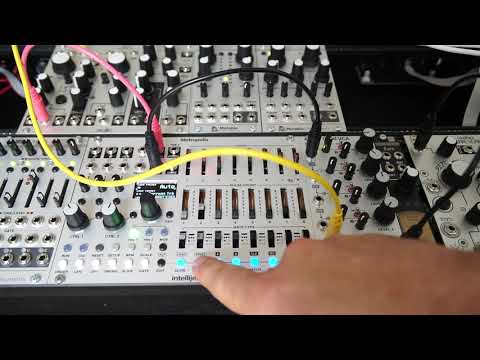Hi Andre,
Analog circuits (like those found in Quad VCA, other analog VCAs, mixers, filters, etc.) tend to saturate or distort at higher levels of gain. This is often called “driving” or adding “drive” to the signal, and can result in added harmonics. This is a normal behavior and is often actually desirable, depending on the circumstance. However, in this case, it may be that the CV signal the Quad VCA is receiving is too high and is pushing the VCA beyond it’s intended limits, so some noise is being introduced into the audio signal.
In your video you will notice that the crackling sound becomes apparent when the response curve knob is set to extreme exponential values on the left. This is to be expected because you’re getting a much higher boost to the signal level (compared to the boost you would be getting with a linear response, the right side of that knobs range) with the same CV signal. If you still want to use a more exponential response, rather than a linear one, and reduce that crackling, I would recommend trying these things in different combinations and amounts: 1. Turn your Level 1 knob all of the way down, 2. Use a less extreme exponential response by turning the knob to the right by small amounts until you find something that you like, 3. Turn down the CV input attenuator (the leftmost knob) to lower levels until you hear the crackling go away.
You also mentioned that this isn’t an issue when using an envelope rather than a raw gate. This is probably because the envelope’s level doesn’t go as high as the gate’s level. It is less common to send a raw gate signal to control a VCA that is processing an audio signal, and the Quad VCA may have been designed with that in mind, and so, is expecting a particular voltage range at the CV input. If you still want to use a raw gate, rather than an envelope, in this particular patch, you may be able to decrease the level that the gate goes to in the Metropolix’s settings (although, I have not used a Metropolix, so don’t know for sure). But in the end, it would be simpler to just turn down the CV input attenuator on the Quad VCA, as mentioned above, and you’d probably get the same result.
Also, I can’t see what kind of output you’re using. If you’re not using some sort of module or other method of bringing the signal down to a standard line level from Eurorack levels, you might be getting the noise in your headphones/monitors from the high signal level, rather than from the VCA itself.
If you try sending that audio signal through a low-pass filter (LPF) before or after it goes through the Quad VCA, you may find that crackling to disappear or even add a pleasing character to the sound, depending on your tastes. From what I can see of your rack in the video, I don’t see any type of standard filter present. (I know that Rings is tagged as a filter on Modular Grid, but that is a bit misleading and can be especially confusing to people newer to synthesis as Rings works quite differently than an LPF, for example.) If you do not already have one, I would highly recommend getting at least an LPF for your setup, especially if you are using an oscillator like DPO - to tame down some of the harsh and harmonically rich waveforms that it’s capable of putting out.
I hope some of that helps! Hopefully I wasn’t misleading either, and if someone does see something that I’ve said incorrectly, please correct me.
Chace
